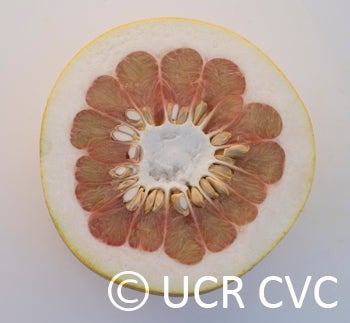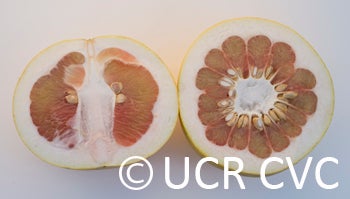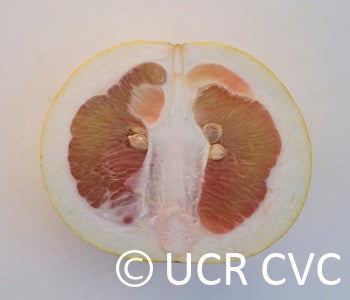Citrus maxima (Burm.) Merr. RUTACEAE
CRC 2244
PI 539359, 109702
CPB 10312
Source
"Originally received as seed...received 08/11/1925 (at USDA-PIO)" (information from original PI record). Accession was collected in 1925, Java, Indonesia. Received as a cutting at Riverside in 1987.
Parentage/origins
Parents unknown.
Rootstocks of accession
Carrizo citrange
Season of ripeness at Riverside
October to November
Notes and observations
Especially selected pink-fleshed shaddock. Plants growing at the United States Plant Introduction Garden...originally grown by the Office of Crop Physiology and Breeding...numbered in January 1935 for convenience in distributions. (information from original PI record)
Four cuttings received from CPB 1929 and 1930. Planted in lath house and balled out March 1932. Planted in Field S1, Block D, Row 24, Trees 9, 10, 11, 12. One tree on sweet from CES nursery planted field 1, ABC, Row 41, Tree 44, May 1931. (Un-dated archival record on file at NCGRCD/CVC)
Bitters/Brusca comments: Light crop. Smooth fruit. Obovatae with thick peel, green flesh. Moderate seed. Good taste. Not mature. A trace of pink in fruit from S1D-24-11, not in fruit from 24-12. (3/10/54, University of California archival material on file at NCGRCD/CVC)
This is a US Date Garden red-fleshed shaddock of good quality. Smooth fruit, obovate with thick peel, moderate seed; good taste, tart; flesh greenish-yellow with definite pink tinge; rind only medium-thick." (Anon, 1957, University of California archival material on file at NCGRCD and CVC)
Most fruit on ground. Flesh greenish-yellow with definite pink tinge; indicates this budline was derived from S1D-24-11 (see above). Rind is only medium,-sthick; flavor good, tart. (EM Nauer, 1/13/1988)
Note: This accession was previously associated with another PI (539359) that was mistakenly assigned, apparently without knowledge of this correct PI of 109702 (probably because PI was assigned after this was received at CES with only a CPB number). Note: Observation data was generated as PI 539359 and also appears in that record. (RRK, 02/2008)
To complete the planting record at UCR: trees were planted in 8A-13-2,3 on C taiwanica in 1961 (budsource: S1D-24-9); 7B-47-5,6 on Carrizo, Limoneira RL in 1966, 1969 (budsource: 8A-13-2); 12A-38-1,2 (Carrizo, C-35) in 1983 (budsource: 7B-47-6). This indicates that the current accession was derived from S1D-24-9 rather than S1D-24-11 as stated by Ed Nauer. S1D-24-9 is also indicated as the source in Bill Bitters's archival materials. (RR Krueger, 07/29/2013)
Description from The Citrus Industry Vol. 1 (1967)
"Fruit large, broadly obovate to short pyriform with shallow depression at apex; nearly seedless. Light yellow at maturity in California, but probably pink-tinted in semitropical climates. Rind medium-thick; surface smooth; tightly adherent. Segments numerous and carpellary membranes moderately tough, but commonly split open at axis at maturity. Flesh coarse-grained, pink-tinged; very juicy; flavor grapefruit-like (subacid with trace of bitterness). Late in maturity.
Tree vigorous, very large, and spreading; leaves typical—broad-pointed; twigs and shoot growth faintly pubescent.
This clone, which was received by the Citrus Experiment Station, Riverside, from the U.S. Department of Agriculture in 1929 under the name Siamese Pink (CES 2246) corresponds ell with the variety Siam, named and described by Wester (1917). According to Wester, it was introduced into the Philippine Islands in 1913. In California, when fully ripe it is clearly one of the best in flavor, although sometimes it has a trace of bitterness."
Availability
Not commercially available in California.
USDA Germplasm Resources Information Network page for Pink pummelo (CRC 2244)



